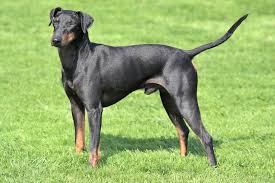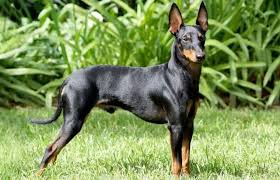The Manchester Terrier, also known as the Gentleman’s Terrier, is a breed that embodies elegance, intelligence, and unwavering loyalty. This spirited and agile dog has a rich history, remarkable physical attributes, and a charming personality that make it a beloved companion for many dog lovers worldwide. Whether you’re searching for a loyal family pet or a dedicated working partner, the Manchester Terrier is sure to impress.
The Manchester Terrier originated in 19th century England and owes its name to the city of Manchester, a hub for dog breeding and textile mills. It is believed to be a result of crossbreeding between the Whippet and the Black and Tan Terrier, with the aim of creating a breed that excelled in both hunting and ratting. Over time, the breed’s popularity expanded beyond its working capabilities, and it became a treasured companion in Victorian households.
The Manchester Terrier possesses a sleek and compact body that showcases its agility and athleticism. It has a distinct head with a keen expression, thanks to its almond-shaped, dark eyes and small, erect ears. One of its most notable physical features is its coat, which is short, dense, and shiny.
The breed comes in two varieties: the Toy Manchester Terrier, weighing up to 12 pounds (5.4 kg), and the Standard Manchester Terrier, weighing between 12 and 22 pounds (5.4 to 10 kg).
With an intelligent and alert nature, the Manchester Terrier is a quick learner and highly trainable. This breed thrives on mental stimulation and enjoys participating in various activities such as obedience training, agility courses, and even canine sports like flyball and rally. They are known to be sensitive to their owners’ moods, making them intuitive companions. Despite their small size, Manchester Terriers possess a big heart filled with loyalty and affection for their families.
Manchester Terriers are generally good with children and can form strong bonds with all family members. Their energetic nature means they will happily engage in playtime and exercise sessions, making them suitable for active households. Early socialization and proper training are crucial to ensure they grow up to be well-rounded, confident dogs. Due to their strong prey drive, it’s important to supervise them around small animals, as they may see them as potential prey.
Manchester Terriers are low-maintenance when it comes to grooming. Their short coat requires minimal brushing to keep it looking sleek and glossy. They are a relatively healthy breed, but like any dog, they should receive regular veterinary check-ups, a balanced diet, and sufficient exercise to maintain their overall well-being. Mental stimulation is also crucial for this intelligent breed, so providing them with puzzle toys and interactive games will keep them entertained and content.
In addition, the Manchester Terrier is a remarkable breed that combines elegance, intelligence, and unwavering loyalty. Whether you’re seeking a working partner, a family pet, or a companion for various activities, this breed’s agility, trainability, and affectionate nature make it an excellent choice. The Manchester Terrier’s rich history and distinctive physical features only add to its appeal, ensuring that it continues to be a cherished breed among dog enthusiasts worldwide.
Read Also: Handling of Poultry Chicks on Arrival and Management of Chicks in the Brooder
History and Origin of the Manchester Terrier Dogs

The Manchester Terrier has an interesting history that dates back to 19th century England. The breed was developed in the city of Manchester, which was a center for both dog breeding and textile mills during that time.
The exact origins of the Manchester Terrier are not well-documented, but it is believed to be a result of crossbreeding between the Whippet and the Black and Tan Terrier. Breeders aimed to create a small, agile dog that excelled in hunting and ratting. The Whippet contributed to the Manchester Terrier’s sleek and athletic physique, while the Black and Tan Terrier provided its distinct coloration and tenacious hunting instincts.
Initially, the Manchester Terrier was primarily used as a working dog, prized for its ability to catch rats and other vermin. It was highly valued in textile mills, where it kept the premises free from rodents.
The breed’s incredible speed, agility, and keen sense of smell made it an effective hunter. However, over time, the Manchester Terrier’s popularity extended beyond its working abilities, and it began to be appreciated as a companion and show dog.
During the Victorian era, the breed gained significant recognition and became a favorite among the upper class. Its elegance, intelligence, and charming personality made it a beloved companion in many households. The Manchester Terrier even earned the nickname “Gentleman’s Terrier” due to its refined appearance and dignified demeanor.
In 1860, the breed’s first breed standard was established, and it was officially recognized as the Manchester Terrier. Throughout the years, breeders continued to refine the Manchester Terrier’s traits and characteristics, focusing on preserving its unique qualities while ensuring its health and temperament.
Today, the Manchester Terrier is cherished not only as a companion but also as a competitive show dog and skilled athlete. Its rich history as a working breed and its enduring popularity as a loyal companion have secured its place in the hearts of dog enthusiasts worldwide.
Health Issues and Lifespan of Manchester Terrier Dogs

The Manchester Terrier is generally a healthy breed with a good lifespan compared to some other dog breeds. However, like all breeds, they can be prone to certain health issues. Here are some common health concerns associated with Manchester Terriers:
Von Willebrand’s Disease: This is a bleeding disorder caused by a deficiency in clotting factor. It can result in excessive bleeding after injuries or surgeries. Responsible breeders can screen their breeding stock for this condition to reduce the risk in offspring.
Legg-Calvé-Perthes Disease: This is a condition that affects the hip joint and leads to the deterioration of the femoral head. It can cause lameness and pain. Surgical intervention may be required to alleviate the discomfort.
Patellar Luxation: This condition involves the displacement of the kneecap, which can lead to lameness and difficulty in walking. Depending on the severity, treatment options range from physical therapy to surgical correction.
Progressive Retinal Atrophy (PRA): PRA is a degenerative eye disorder that causes progressive vision loss and can eventually lead to blindness. Responsible breeders will have their breeding dogs tested for PRA to help reduce the incidence of this condition.
It’s important to note that not all Manchester Terriers will develop these health issues, and many individuals lead long and healthy lives. Regular veterinary check-ups, a balanced diet, and sufficient exercise are essential for maintaining their overall well-being.
The average lifespan of a Manchester Terrier is typically between 12 and 16 years. With proper care, nutrition, and a healthy lifestyle, some individuals may even exceed this range.
If you are considering getting a Manchester Terrier, it’s advisable to seek a reputable breeder who conducts health screenings on their breeding dogs to minimize the risk of inherited health issues. Additionally, providing your dog with regular veterinary care, a nutritious diet, and an active lifestyle will contribute to their overall health and longevity.
Read Also: Saint Bernard Puppies: Description and Complete Care Guide
Manchester Terrier Dog Breed Complete Grooming and Care Guide

Grooming and care are essential aspects of keeping your Manchester Terrier healthy, happy, and looking their best. Here’s a complete guide to grooming and caring for your Manchester Terrier:
Coat Care:
The Manchester Terrier has a short, dense, and glossy coat that requires minimal grooming. Here are some tips for coat care:
Brushing: Brush your Manchester Terrier’s coat once or twice a week using a soft-bristled brush or a grooming mitt. This helps remove loose hairs and keeps the coat looking sleek.
Bathing: Bathe your Manchester Terrier as needed, typically every 6-8 weeks or when they get dirty. Use a gentle dog shampoo and warm water. Avoid over-bathing, as it can strip the natural oils from their skin.
Ears: Check their ears regularly for signs of wax buildup, redness, or odor. Clean their ears with a veterinarian-recommended ear cleaner and a cotton ball, being careful not to insert anything deep into the ear canal.
Nails: Trim their nails every few weeks using a dog nail clipper or grinder. Be cautious not to cut into the quick, which can cause bleeding and discomfort. If you’re unsure, consult a professional groomer or veterinarian.
Dental Care: Brush your Manchester Terrier’s teeth several times a week using a dog-specific toothbrush and toothpaste. This helps prevent dental issues such as tartar buildup and gum disease.
Exercise and Mental Stimulation:
Manchester Terriers are an active and intelligent breed. Providing them with regular exercise and mental stimulation is important for their overall well-being. Here’s what you can do:
Daily Walks: Take your Manchester Terrier for daily walks to help them burn off energy and stimulate their minds. Aim for at least 30 minutes to an hour of exercise per day.
Interactive Toys: Provide them with puzzle toys, treat-dispensing toys, and interactive games to keep their minds engaged and prevent boredom.
Training and Agility: Enroll your Manchester Terrier in obedience training classes or engage in agility training. These activities not only provide mental stimulation but also strengthen the bond between you and your dog.
Playtime: Engage in active play sessions with your Manchester Terrier, whether it’s playing fetch, tug-of-war, or participating in canine sports like flyball or rally.
Healthcare and Nutrition:
Maintaining your Manchester Terrier’s health involves regular veterinary care and providing them with a balanced diet. Here are some guidelines:
Veterinary Check-ups: Schedule regular visits to the veterinarian for vaccinations, routine examinations, and preventive care. Your vet will also advise on parasite control and recommend necessary screenings.
Balanced Diet: Feed your Manchester Terrier a high-quality dog food appropriate for their age, size, and activity level. Follow the recommended feeding guidelines and avoid overfeeding, as obesity can lead to health problems.
Hydration: Always provide fresh and clean water for your Manchester Terrier. Ensure they have access to water throughout the day.
Weight Management: Monitor your dog’s weight and body condition regularly. Obesity can lead to various health issues, so consult your veterinarian for guidance on maintaining a healthy weight.
Vaccinations and Parasite Control: Stay up-to-date with vaccinations and follow your veterinarian’s recommendations for parasite prevention, including fleas, ticks, and intestinal worms.
By following this grooming and care guide, you can ensure that your Manchester Terrier remains healthy, well-groomed, and enjoys a fulfilling life as your beloved companion.
Read Also: Why Enfamil Infant Formula is a Smart Choice for Your Baby’s Health





